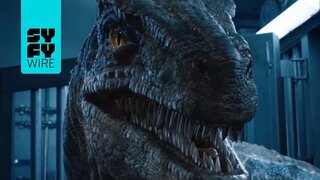Create a free profile to get unlimited access to exclusive videos, sweepstakes, and more!
These Prehistoric Plant Fossils Are Actually Baby Turtles in Disguise
It's a rock, it's a plant... it's an ancient baby turtle!
The mad scientists at Jurassic Park (later Jurassic World) were no strangers to hybrid organisms. Their earliest dinosaurs were necessarily genetic mashups, using modern amphibian DNA to fill in the gaps in the dinosaur genome. Later, they hybridized dinosaurs on purpose to create new and exciting attractions like the Indominus rex, to their utter dismay.
Usually, real-world paleontology is a lot less wiggly; the nature of a fossil is generally set in stone (puns!). Sometimes, a particular fossil might be classified first as one species and later as another. New information allows for new interpretations and things get updated over time, but you don’t usually see a fossil jump from one biological kingdom to another. Recently though, paleontologists uncovered two fossils of a prehistoric plant which are actually turtles in disguise.
Just Like Turtwig, This Fossil “Plant” Is Actually a Turtle
The fossils were collected by priest and naturalist Gustavo Huertas sometime between the 1950s and ‘70s. Huertas collected dozens of fossils over the course of decades and published much of his findings. His final work, published in 2003, included the classification of a number of plant fossils from the La Paja Formation in Colombia, and two misclassified baby turts.
RELATED: Scientists Pull Gigantic Prehistoric Sea Monster Skull from Dorset Cliff Face
The fossils in question are small and ovular with a line running down the middle and smaller lines branching off from the side. It’s not difficult to see how Huertas, accustomed to finding and working with prehistoric plants, saw the veins of a leaf in the stony impressions. Huertas listed the two fossils as examples of Sphenophyllum colombianum, part of an extinct genus of plant which lived from the Devonian to the Early Triassic, approximately 360 million to 251 million years ago. The only trouble: the formation where Huerta found them is too young; the fossils are dated to between 132 million and 113 million years ago.
The mystery spurred a new generation of scientists including paleobotanists Héctor Palma-Castro and Fabiany Herrera to revisit the Huerta collection. When they came across the alleged S. colombianum fossils they knew something wasn’t quite right. It was missing some of the characteristic elements of typical plant fossils. “We knew it wasn’t a plant, but we didn’t know what it was,” Palma-Castro told SYFY WIRE. So, they reached out to Edwin-Alberto Cadena, an expert in prehistoric turtles, who confirmed that the fossils were of a preserved turtle carapace. Their new analysis of the fossils was published in the journal Paelontologia Electronica.
RELATED: Discovery of Freshwater Plesiosaurs Makes Loch Ness Monster ‘Plausible’
“We are looking at the ventral view of the carapace. So, we’re looking at the inside. We can see the impression of the vertebrae and the impression of the ribs,” Palma-Castro said. It was those impressions which looked like the veins of a leaf and led to the original misclassification.
Because the actual bones are missing and because we can only see the underside of the shell, researchers weren’t able to get enough information to determine the species of the turtles, but we do know they were babies. Adult turtles in this region regularly get to two meters in length, and researchers estimate these individuals died within the first year of life. They were also able to identify a characteristic typical of marine turtles, but that’s about all that we know right now.
Excited as they were at the scientific merits of the find, researchers couldn’t help reliving their childhoods just a little bit. “Me and Diego, we play Pokémon. When we started to work on this fossil, we thought it was like half plant and half turtle. Then we thought about Turtwig because it’s the same, a small turtle with a leaf on his head,” Palma-Castro said. An early version of the paper was titled “Who’s That Pokemon: Fossil Plant or Turtle, but the (maybe overexcited) researchers were advised against such a frivolous title by cooler heads. For what it’s worth, we think that science and fun can co-exist.
Although, when frivolity in science goes unchecked, you end up with Jurassic World Dominion (streaming now on Peacock). Maybe a little caution, even in naming, is best.
































